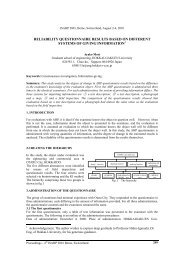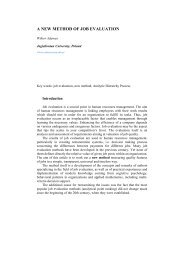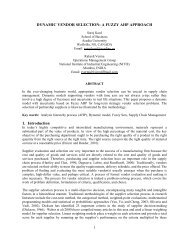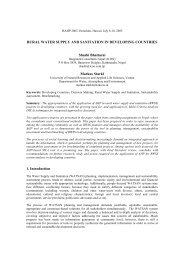a restaurant planning model based on fuzzy-ahp method
a restaurant planning model based on fuzzy-ahp method
a restaurant planning model based on fuzzy-ahp method
Create successful ePaper yourself
Turn your PDF publications into a flip-book with our unique Google optimized e-Paper software.
ISAHP 2005, H<strong>on</strong>olulu, Hawaii, July 8-10, 2003<br />
A RESTAURANT PLANNING MODEL BASED ON FUZZY-AHP METHOD<br />
Heung Suk Hwang 1<br />
1: Department of Business Administrati<strong>on</strong>, Kainan University, Taiwan<br />
No. 1 Kainan Rd., Lu-jhu, Taoyuan, Taiwan 338,<br />
e-mail : hshwang@mail.knu.edu.tw<br />
Wen-Hwa Ko 2<br />
2: Department of Business Tourism and Hospitality Management, Kainan University, Taiwan<br />
No. 1 Kainan Rd., Lu-jhu, Taoyuan, Taiwan 338,<br />
e-mail : kowh@mail.knu.edu.tw<br />
Keywords: Restaurant Locati<strong>on</strong> Planning, AHP, Stochastic Set-covering Problem<br />
Summary: Recently, a new <strong>method</strong> of optimizing the <str<strong>on</strong>g>restaurant</str<strong>on</strong>g> <str<strong>on</strong>g>planning</str<strong>on</strong>g> for the decisi<strong>on</strong> of <str<strong>on</strong>g>restaurant</str<strong>on</strong>g><br />
types, the locati<strong>on</strong>s and food service system. The multi-criteria decisi<strong>on</strong> analysis is <strong>on</strong>e of the evident<br />
areas of important points in integrated <str<strong>on</strong>g>planning</str<strong>on</strong>g> of the <str<strong>on</strong>g>restaurant</str<strong>on</strong>g> service system.<br />
This research is c<strong>on</strong>cerned with the development of a 3-step <str<strong>on</strong>g>restaurant</str<strong>on</strong>g> <str<strong>on</strong>g>planning</str<strong>on</strong>g> <str<strong>on</strong>g>based</str<strong>on</strong>g> <strong>on</strong> service level,<br />
multi-criteria decisi<strong>on</strong> analysis, and stochastic set-covering <strong>method</strong>. Following three researches are<br />
included;; 1) optimal decisi<strong>on</strong> of <str<strong>on</strong>g>restaurant</str<strong>on</strong>g> types using analytic hierarchy process and <strong>fuzzy</strong>-AHP as a<br />
multi-criteria decisi<strong>on</strong> analysis <strong>method</strong>, 2) determine the optimal number of <str<strong>on</strong>g>restaurant</str<strong>on</strong>g> and those<br />
locati<strong>on</strong>s with minimum customers travel distance using set-covering problem, and 3) these procedures<br />
are shown <strong>on</strong> visual outputs by a computer program. The computer program is developed and<br />
dem<strong>on</strong>strated the computati<strong>on</strong>al results for school food service facility of Taoyuan area in Taiwan. It is<br />
known that the proposed <strong>method</strong> is very effective <strong>on</strong> a set of test problems.<br />
1. Introducti<strong>on</strong><br />
Restaurant facility <str<strong>on</strong>g>planning</str<strong>on</strong>g> is an import analysis leading to the success of <str<strong>on</strong>g>restaurant</str<strong>on</strong>g> management<br />
because it can determine the type and required number of <str<strong>on</strong>g>restaurant</str<strong>on</strong>g> with optimal locati<strong>on</strong>s. There are<br />
many studies performed <strong>on</strong> facility <str<strong>on</strong>g>planning</str<strong>on</strong>g> and locati<strong>on</strong> problems such as; Aly and White (1998), Appl<br />
and Rickleres (1987), Francis and White (1974), and Tomkins et al. (1996). However, the most of these<br />
researches are c<strong>on</strong>cerned with material handling systems. Although there are some of researches <strong>on</strong><br />
foodservice operati<strong>on</strong>s’ efficiency by focusing <strong>on</strong> variables affecting productivity such as; Brown and<br />
Hoover (1990), Clark (1997), Lieux and Winkler (1989), Manning and Lieux (1991), Manning and Lieux<br />
(1995), Mayo and Olsen (1984). These studies failed to provide a basis <strong>on</strong> which the comprehensive<br />
performance criteria in terms of integrated decisi<strong>on</strong>, goal achievement and identify relative weights of<br />
decisi<strong>on</strong> criteria are determined. Most of these <str<strong>on</strong>g>model</str<strong>on</strong>g>s and researches have been developed for the design<br />
of facilities and its locati<strong>on</strong> problems. However these techniques provide invaluable informati<strong>on</strong> for<br />
integrated a decisi<strong>on</strong> system for <str<strong>on</strong>g>restaurant</str<strong>on</strong>g> facility <str<strong>on</strong>g>planning</str<strong>on</strong>g>, <strong>on</strong> the other hand this research is c<strong>on</strong>cerned<br />
with optimizing the locati<strong>on</strong> and service level for <str<strong>on</strong>g>restaurant</str<strong>on</strong>g> facilities <str<strong>on</strong>g>planning</str<strong>on</strong>g> <str<strong>on</strong>g>based</str<strong>on</strong>g> <strong>on</strong> analytic<br />
approach c<strong>on</strong>sidering the customers required service level, optimal number and the possible locati<strong>on</strong>s of<br />
<str<strong>on</strong>g>restaurant</str<strong>on</strong>g> facilities. We develop a three-step approach using optimizing <strong>method</strong>s as explained following.<br />
In step 1, we decided the <str<strong>on</strong>g>restaurant</str<strong>on</strong>g> alternative such as the type and service level of the <str<strong>on</strong>g>restaurant</str<strong>on</strong>g> for the<br />
regi<strong>on</strong>al customers.<br />
1. Corresp<strong>on</strong>ding Author
In this step, we decide the type of facility alternative, possible locati<strong>on</strong>s, service levels c<strong>on</strong>sidering all the<br />
facility characteristics, and we developed a 3-step soluti<strong>on</strong> builder and apply it to implement the facility<br />
alternative such as; 1) brainstorming <str<strong>on</strong>g>model</str<strong>on</strong>g> to generate the <str<strong>on</strong>g>restaurant</str<strong>on</strong>g> alternative, 2) multi-criteria<br />
decisi<strong>on</strong> analysis <str<strong>on</strong>g>model</str<strong>on</strong>g> to evaluate the individual alternatives using AHP (analytic hierarchy process)<br />
and <strong>fuzzy</strong> set ranking <strong>method</strong>ologies to overcome the special decisi<strong>on</strong> problems of <str<strong>on</strong>g>restaurant</str<strong>on</strong>g>, and 3)<br />
sector clustering <str<strong>on</strong>g>model</str<strong>on</strong>g> to cluster the customers for every <str<strong>on</strong>g>restaurant</str<strong>on</strong>g> optimizing total regi<strong>on</strong>al<br />
performance. In step 2, we determine the optimal number of <str<strong>on</strong>g>restaurant</str<strong>on</strong>g> facility needed to meet the<br />
customer’s service level. We use a stochastic network simulati<strong>on</strong> and 0-1 programming, and in step 3, we<br />
decide the groups of customers using sector clustering algorithm for each <str<strong>on</strong>g>restaurant</str<strong>on</strong>g> facility so as to<br />
guarantee to meet the required service level (Potvnt, 1996). Finally, we develop the computer programs<br />
for this procedure. Figure 1 shows the three-step approach of the decisi<strong>on</strong> support system for <str<strong>on</strong>g>restaurant</str<strong>on</strong>g><br />
<str<strong>on</strong>g>planning</str<strong>on</strong>g>.<br />
Figure 1. Three-step approach of <str<strong>on</strong>g>restaurant</str<strong>on</strong>g> <str<strong>on</strong>g>planning</str<strong>on</strong>g><br />
2. Restaurant Type Evaluati<strong>on</strong> Using Fuzzy-AHP<br />
2.1 Web-Based Soluti<strong>on</strong> Builder<br />
We develop three steps decisi<strong>on</strong> soluti<strong>on</strong> builder to decide the types of <str<strong>on</strong>g>restaurant</str<strong>on</strong>g>. In the first step, we<br />
develop a brainstorming <strong>method</strong> <str<strong>on</strong>g>based</str<strong>on</strong>g> <strong>on</strong> an internet/intranet to create the ideas to drive out alternatives<br />
<str<strong>on</strong>g>based</str<strong>on</strong>g> <strong>on</strong> the group analysts, and in the sec<strong>on</strong>d step, we evaluate the decisi<strong>on</strong> alternatives that derived out<br />
in the step 1 using the AHP <strong>method</strong> and determined the preferred alternative. In the last step, we<br />
integrate the results of individual evaluati<strong>on</strong>s into <strong>on</strong>e ranked order. We developed two heuristic <strong>method</strong>s<br />
<str<strong>on</strong>g>based</str<strong>on</strong>g> <strong>on</strong> majority rule <strong>method</strong> for this last step. Figure 2 shows the schematic structure of three-step<br />
approach.<br />
3-Step 3-step 3단계알고리즘적용을통한최적솔류션선정<br />
Algorithm for for Optimal Optimal Soluti<strong>on</strong><br />
Soluti<strong>on</strong><br />
Brainstorming<br />
AHP,<br />
Fuzzy-AHP<br />
-<br />
Aggregate<br />
Priorities<br />
Figure 2. Structure of 3-step soluti<strong>on</strong> builder for decisi<strong>on</strong> support system<br />
1) AHP and <strong>fuzzy</strong>-AHP <strong>method</strong>: In this study we used AHP and <strong>fuzzy</strong>-AHP <strong>method</strong> to evaluate<br />
individual <str<strong>on</strong>g>restaurant</str<strong>on</strong>g> alternatives. The <strong>fuzzy</strong> priority is computed and compared with the rank order of the<br />
other <strong>method</strong>s. The fundamental c<strong>on</strong>cept of <strong>fuzzy</strong> set priority relati<strong>on</strong>, R, is derived from the result<br />
obtained by Shann<strong>on</strong> (1986) <strong>method</strong>. From the Shann<strong>on</strong>'s summed frequency matrix for complementary<br />
cells, A and<br />
ij<br />
A ji<br />
, an additi<strong>on</strong>al <strong>fuzzy</strong> set matrix is made by c<strong>on</strong>sidering A = 1 -<br />
ij<br />
A for all cells.<br />
ji<br />
To obtain <strong>fuzzy</strong> preferences, the following five steps are c<strong>on</strong>sidered:<br />
Step 1: Find the summed frequency matrix (using Shann<strong>on</strong> <strong>method</strong>)<br />
Step 2: Find the <strong>fuzzy</strong> set matrix R which is the<br />
Summed frequency matrix divided by the total number of evaluators
Step 3: Find the difference matrix<br />
R- R T = U (A, B)-U (B, A), if U (A, B) > U (B, A),<br />
= 0, otherwise<br />
where, for U(A,B) quantifies, A is preferable to B.<br />
Step 4: Determine the porti<strong>on</strong> of each project that is not dominated as follows:<br />
ND<br />
A = 1- max (<br />
ColA<br />
X 1 .<br />
,<br />
ColA<br />
X 2 .<br />
, … ,<br />
ColA<br />
X<br />
n .<br />
)<br />
ColA<br />
Step 5: The priority of the <strong>fuzzy</strong> set is then the rank order of XND values with a decreasing order.<br />
An example is shown as follows:<br />
⎡0.0<br />
0.8 0.6 0.6 0.0⎤<br />
⎡0.0<br />
0.2 0.4 0.4⎤<br />
⎢<br />
⎥<br />
R = 0.2 0.0 0.0 0.4<br />
⎢<br />
⎥ R T = ⎢0.8<br />
0.0 0.1 0.6⎥<br />
0.4 0.1 0.0 0.4 ⎢<br />
⎥<br />
⎢<br />
⎥<br />
0.6 0.0 0.0 0.6<br />
⎢<br />
⎥<br />
⎢⎣<br />
0.4 0.6 0.6 0.0⎥⎦<br />
⎢⎣<br />
0.6 0.4 0.4 0.0⎥⎦<br />
⎡0.0<br />
0.6 0.2 0.2⎤<br />
⎢<br />
⎥<br />
T 0.0 0.0 0.0 0.0<br />
R − R = ⎢<br />
⎥<br />
0.0 0.1 0.0 0.0<br />
⎢<br />
⎥<br />
⎢⎣<br />
0.0 0.2 0.2 0.0⎥⎦<br />
ND<br />
ND<br />
X = 1 - Max (0.0) = 1 - 0.0 = 1.0, X = 1 - Max (1.0) = 1 – 0.6 = 0.4<br />
A<br />
ND<br />
C<br />
X = 1 - Max (0.2) = 1 - 0.2 = 0.8,<br />
B<br />
ND<br />
D<br />
X = 1 - Max (0.2) = 1 - 0.2 = 0.8<br />
Thus, the <strong>fuzzy</strong> set priority score of this example is given by 1.0 > 0.8 > 0.8 > 0.4 and the alternative<br />
priority is given by A > C > D > B.<br />
2) Integrati<strong>on</strong> of Individual Evaluati<strong>on</strong>: For the integrati<strong>on</strong> of the results of individual evaluati<strong>on</strong>s and<br />
prioritized sets, we use a heuristic <strong>method</strong> which is a kind of majority-rule and <strong>fuzzy</strong> set priority <strong>method</strong>s.<br />
This <strong>method</strong> is compared to other <strong>method</strong>s to determine the most preferred <strong>on</strong>e for the decisi<strong>on</strong> support<br />
system purpose.<br />
- Heuristic Model: In this <strong>method</strong>, the preference score is given by the sum of the marks received from<br />
the evaluators, where for m alternatives, the marks are given, in decreasing order preference, (m-1), (m-<br />
2), ..., 0. The ranking is <str<strong>on</strong>g>based</str<strong>on</strong>g> <strong>on</strong> the scores of each alternative. In this case, the highest score is the first<br />
priority. For example of the heuristic <strong>method</strong>, a sample results of a problem with N = 5 evaluators and M<br />
= 3 alternatives are given as Table 1:<br />
Table 1. Example result of heuristic <strong>method</strong><br />
Alt. Preference matrix Raw sum Weighed value<br />
School A<br />
School B<br />
School C<br />
0.0 1.0 1.0<br />
4.0 0.0 2.0<br />
4.0 3.0 0.0<br />
2.0<br />
6.0<br />
7.0<br />
0.133<br />
0.400<br />
0.467<br />
Heuristic Method<br />
Rank Order<br />
C > B > A<br />
Evaluator 1: B > A > C, Evaluator 2: B > C > A, Evaluator 3: C > A > B,<br />
Evaluator 4: C > B > A, Evaluator 5: C > B > A<br />
We developed the computer program and applied to a set of example problems of multi-structured<br />
<str<strong>on</strong>g>restaurant</str<strong>on</strong>g> <str<strong>on</strong>g>planning</str<strong>on</strong>g> problems.<br />
2.2 Sample Problem of Restaurant Alternative Evaluati<strong>on</strong><br />
For a sample problem of <str<strong>on</strong>g>restaurant</str<strong>on</strong>g> alternative evaluati<strong>on</strong> using three step decisi<strong>on</strong> <str<strong>on</strong>g>model</str<strong>on</strong>g>s, a new<br />
<str<strong>on</strong>g>restaurant</str<strong>on</strong>g> for school food service problem is c<strong>on</strong>sidered. We used the <str<strong>on</strong>g>model</str<strong>on</strong>g> according to following three<br />
steps where we have to decide the <str<strong>on</strong>g>restaurant</str<strong>on</strong>g> type and evaluati<strong>on</strong> factors such as; 1) In step 1, to decide<br />
the evaluati<strong>on</strong> factors and <str<strong>on</strong>g>restaurant</str<strong>on</strong>g>s alternatives using brainstorming process and we c<strong>on</strong>verted this<br />
result into AHP-evaluati<strong>on</strong> structure automatically by program, 2) in step 2, using a heuristic and <strong>fuzzy</strong>-<br />
AHP <strong>method</strong>, we find the eigen value by pair-wise comparis<strong>on</strong> matrix. This evaluati<strong>on</strong> is d<strong>on</strong>e by 4
evaluati<strong>on</strong> members and 3) in step 3, the results of individual evaluators are integrated by heuristic and<br />
<strong>fuzzy</strong> set priority <strong>method</strong>s. Following tables and figures summarized the sample outputs of this problem.<br />
1) Brainstorming Module: In step 1, by brainstorming <strong>method</strong> we found the <str<strong>on</strong>g>restaurant</str<strong>on</strong>g> alternative and<br />
evaluati<strong>on</strong> factors as following;<br />
- Restaurant alternative (4 alternatives); full outsourcing type, partial owner and partial outsourcing<br />
type, short term c<strong>on</strong>tract type, and full own and operating type.<br />
- Evaluati<strong>on</strong> factors (3 factors); cost, quality, and food flexibility.<br />
Figure 3 and 4 show the brainstorming output and c<strong>on</strong>verted into AHP structure respectively.<br />
Figure 3. Sample output of brainstorming (Evaluati<strong>on</strong> factors)<br />
2) Evaluati<strong>on</strong> of Alternative: Step 2<br />
Figure 4 and 5 show the sample output of this example problem.<br />
Figure 4. Sample output of AHP structure diagram
Figure 5. Sample output of pair-wise comparis<strong>on</strong><br />
Figure 6. Sample output of evaluati<strong>on</strong> by level<br />
Figure 6 shows a sample output of alternative generati<strong>on</strong> and c<strong>on</strong>struct the decisi<strong>on</strong> structure of the<br />
sample result of an evaluator. The final result of <str<strong>on</strong>g>restaurant</str<strong>on</strong>g> by <strong>fuzzy</strong>-AHP is given by:<br />
C1(0.38) > C2(0.27) > C3(0.21) > C4(0.14).<br />
Table 2. Sample output of pair-wise matrix<br />
A B1 B2 B3 Eigen Val.<br />
B1 1.00 2.00 4.00 0.71 λ =3.09<br />
max<br />
B2 0.50 1.00 5.00 0.21 Cl=0.0815<br />
B3 0.25 0.20 1.00 0.08 CR=0.14<br />
B1 C1 C2 C3 C4 Eigen Val<br />
C1 1.00 0.33 0.50 0.50 0.17<br />
C2 3.00 1.00 1.00 2.00 0.34 λ =5.760<br />
max<br />
C3 2.00 1.00 1.00 1.00 0.26 Cl=0.190<br />
C4 2.00 0.50 1.00 1.00 0.23 CR=0.170<br />
B2 C1 C2 C3 C4 Eigen Val<br />
C1 1.00 2.00 4.00 5.00 0.44<br />
C2 0.50 1.00 3.00 7.00 0.30 λ =5.107<br />
max<br />
C3 0.25 0.33 1.00 5.00 0.19 Cl=0.0275<br />
C4 0.20 0.14 0.20 1.00 0.07 CR=0.024<br />
B3 C1 C2 C3 C4 Eigen Val<br />
C1 1.00 3.00 9.00 4.00 0.53<br />
C2 0.33 1.00 1.00 1.00 0.19 λ =5.760<br />
max<br />
C3 0.11 1.00 1.00 3.00 0.17 Cl=0.190<br />
C4 0.25 1.00 0.33 1.00 0.11 CR=0.170
3) Integrati<strong>on</strong> of Individual Evaluati<strong>on</strong>s: Step 3<br />
In this step, we integrated the results of the reviewers by the majority rule. The individual results of 4<br />
reviewers are given by:<br />
Reviewer 1: C1 > C3 > C2 > C4, Reviewer 3: C2 > C1 > C3 > C4,<br />
Reviewer 2: C2 > C1 > C3 > C4, Reviewer 4: C1 > C2 > C4 > C3<br />
Using the Heuristic 1, Heuristic 2 and Fuzzy Set Ranking <strong>method</strong>, we integrated as shown in Table 3:<br />
Table 3. Results of Integrated Priority<br />
Majority Rule used<br />
Priority by alternative<br />
1. Heuristic <strong>method</strong> C2 > C1> C3 > C4<br />
2. Fuzzy set ranking <strong>method</strong> C1 > C2> C3 > C4<br />
In this example, the best <str<strong>on</strong>g>restaurant</str<strong>on</strong>g> alternative for food supply <str<strong>on</strong>g>planning</str<strong>on</strong>g> is known to be alternative C1<br />
(outsourcing)<br />
3. Optimizing Restaurant Locati<strong>on</strong>s and Service Level<br />
According to the decisi<strong>on</strong> of <str<strong>on</strong>g>restaurant</str<strong>on</strong>g> type, the design activity of <str<strong>on</strong>g>restaurant</str<strong>on</strong>g> facility <str<strong>on</strong>g>planning</str<strong>on</strong>g> improves<br />
customer centric services and the <str<strong>on</strong>g>restaurant</str<strong>on</strong>g> performance by implementing optimizing <strong>method</strong> (Hwang,<br />
2000, 2003). We c<strong>on</strong>sider a <str<strong>on</strong>g>restaurant</str<strong>on</strong>g> chain system which is c<strong>on</strong>sisted of several central <str<strong>on</strong>g>restaurant</str<strong>on</strong>g>s and<br />
its general <str<strong>on</strong>g>restaurant</str<strong>on</strong>g>s.<br />
3.1 Optimal Locati<strong>on</strong> and Number of Facilities Using Stochastic Set-Covering Problem<br />
The objective of this secti<strong>on</strong> is to determine the minimum number of <str<strong>on</strong>g>restaurant</str<strong>on</strong>g> facilities am<strong>on</strong>g a discrete<br />
set of possible locati<strong>on</strong> sites so that the probability of each general <str<strong>on</strong>g>restaurant</str<strong>on</strong>g>s to be covered is not less<br />
than a critical value (required service level) (Ally and White,1998). We formulate this problem using a<br />
stochastic set-covering problem which can be solved by 0-1 programming <strong>method</strong>. Also we develop a<br />
computer program for this problem and applied to a sample problem. The results of sample problems for<br />
<str<strong>on</strong>g>restaurant</str<strong>on</strong>g> facility well show the impact of critical values and the number of possible locati<strong>on</strong> sites.<br />
Following assumpti<strong>on</strong>s are used in this study: 1) a <str<strong>on</strong>g>restaurant</str<strong>on</strong>g> <str<strong>on</strong>g>planning</str<strong>on</strong>g> is c<strong>on</strong>sidered, 2) required service<br />
level is c<strong>on</strong>sidered as performance measure of system, 3) covering probability is c<strong>on</strong>sidered, and 4) GISdistance<br />
measure is assumed (Hwang, 2000).<br />
To formulate the problem, we define the system cost F ij as the sum of transportati<strong>on</strong> cost of demand per<br />
period. To compute the amount of system cost to transport from S o to R j , we define following notati<strong>on</strong>s:<br />
ri( XRi, YR<br />
i)<br />
: Locati<strong>on</strong> of students,<br />
S XS , YS ) : Possible locati<strong>on</strong> of a public facility<br />
j ( j j<br />
F R , S ) : Travel cost incurred between ri<br />
and<br />
ij ( i j<br />
A i : required service level, m : Number of students<br />
n : number of public system locati<strong>on</strong>s<br />
C<br />
j : cost of locati<strong>on</strong> a public service at site j<br />
⎡1<br />
if a public service facility is located at site j<br />
X<br />
j ⎢<br />
⎣0<br />
otherwise<br />
r<br />
i<br />
: minimum allowable probability that student I<br />
S j ,<br />
Fij<br />
= ci<br />
⋅ Dist( S<br />
j<br />
, Ri<br />
) ⋅ Di<br />
⋅ Exp(<br />
α<br />
i<br />
⋅Tim(<br />
S<br />
j<br />
, Ri<br />
))<br />
(1)<br />
where, distance Dist S j , R ) is given by lp-distance<br />
( i<br />
p<br />
p 1/ p<br />
Dist ( S j , Ri<br />
) = (| XSj<br />
− XRi<br />
| + | YSj<br />
−YRi<br />
| )<br />
(2)<br />
Using well known the deterministic set-covering problem, we formulate a probabilistic set covering<br />
problems under the assumpti<strong>on</strong>s : 1) <str<strong>on</strong>g>restaurant</str<strong>on</strong>g> facilities are always in available state, and 2) the
traveling time is c<strong>on</strong>sidered as a random variable with known distributi<strong>on</strong>. When we c<strong>on</strong>sider the<br />
required service level as a random variable state, a probabilistic formulati<strong>on</strong> P1 can be given by:<br />
P 1: Minimize<br />
n<br />
∑ C jX<br />
j<br />
j=<br />
1<br />
,<br />
n<br />
Subject to ∑ a ij · X j ≥ 1,<br />
for all i = 1,<br />
,<br />
m<br />
j = 1<br />
X = (0, 1), for all j = 1,<br />
,<br />
n<br />
j<br />
where,<br />
a ij<br />
=<br />
⎡ 1,<br />
⎢<br />
⎣ 0 ,<br />
if<br />
if<br />
Pr ob(<br />
F ≤ A ) ≥ r<br />
ij<br />
otherwise<br />
i<br />
i<br />
This problem can be solved by a 0-1 programming algorithm. The covering coefficient a ij in P1 is<br />
determined under the assumpti<strong>on</strong> that a public service facility is always in available state. This<br />
assumpti<strong>on</strong> can be relaxed by c<strong>on</strong>sidering the probability of a public service facility being in available<br />
state.<br />
Let b j= Prob. (a public service facility is in available state), and P ij = Prob. ( R i is covered by S j ),<br />
then, P ij = a ijb j , and qij<br />
= 1 − Pij<br />
,<br />
Thus, Prob. [ R i is covered by some of the available supply center ] = 1- ∏ q ij (3)<br />
j= θ (x)<br />
where, θ ( X)<br />
= ( j | X<br />
j<br />
= 1, j = 1, ,<br />
n).<br />
The equati<strong>on</strong> (3) leads us to develop another formulati<strong>on</strong> P2 as ;<br />
P 2: Minimize ∑ X j ,<br />
j = 1<br />
Subject to 1 - ∏<br />
n<br />
q ij<br />
j= θ (x)<br />
≥ , for i = 1,<br />
,<br />
m<br />
X = (0, 1), for all j = 1,<br />
,<br />
n<br />
l i<br />
j<br />
where, l i is the probability that R i is covered by some available supply centers with its maximum value<br />
to (1- ∏ q ij ). To make the soluti<strong>on</strong> procedure of P2 more effective, the first c<strong>on</strong>straint can be transformed<br />
as follows:<br />
n<br />
1 - ∏ q ij =1- ∏( qij<br />
) X j ≥ li<br />
, for R i<br />
i = 1,<br />
,<br />
m<br />
j= θ (x)<br />
j=<br />
1<br />
n<br />
thus, 1 - ∏ ( q ) X ≥ 1−<br />
l<br />
(4)<br />
j=<br />
1<br />
ij<br />
j<br />
Taking a logarithmic transformati<strong>on</strong>, equati<strong>on</strong> (4) becomes<br />
Let<br />
n<br />
− ∑ (log<br />
ij<br />
j=<br />
1<br />
q ) X<br />
ij<br />
ij<br />
j<br />
i<br />
≥ − log(1 − l ),<br />
i<br />
s = −logq<br />
, and W = − log( 1−<br />
l ), then, P2 can be reformulated as;<br />
i<br />
i<br />
P 3 :<br />
n<br />
Minimize ∑<br />
Subject to<br />
j = 1<br />
n<br />
ij<br />
j=1<br />
X<br />
j<br />
j<br />
,<br />
∑ s X ≥ W , for i = 1,<br />
,<br />
m<br />
i
X j = (0, 1), for all j = 1,<br />
,<br />
n<br />
This is the form of standard 0-1 programming and can be solved by an appropriate algorithm. We<br />
developed GUI-type program for this stochastic set-covering problem and dem<strong>on</strong>strated sample results in<br />
following secti<strong>on</strong>. We developed the window program to solve this problem.<br />
3.2 Sample Problem of Public Service Facility Locati<strong>on</strong><br />
The objective of this problem is the optimal locati<strong>on</strong> of central <str<strong>on</strong>g>restaurant</str<strong>on</strong>g>s facilities to be open and the<br />
minimum number of central <str<strong>on</strong>g>restaurant</str<strong>on</strong>g>s to cover the general <str<strong>on</strong>g>restaurant</str<strong>on</strong>g>’s service requirements. We used<br />
the stochastic set covering problem <str<strong>on</strong>g>based</str<strong>on</strong>g> <strong>on</strong> GIS.<br />
The major input data are:<br />
- Number of general <str<strong>on</strong>g>restaurant</str<strong>on</strong>g>: 31,<br />
- Number of possible locati<strong>on</strong>s of central supply center: 5,<br />
- Covering probability: 0.80 (it can be changed),<br />
- All the locati<strong>on</strong>s of general <str<strong>on</strong>g>restaurant</str<strong>on</strong>g> and of possible locati<strong>on</strong> of central <str<strong>on</strong>g>restaurant</str<strong>on</strong>g> are given by<br />
characteristics address and these are automatically c<strong>on</strong>verted into visual points in the GIS screen,<br />
- Availability of possible school: 1 st = 0.96, 2 nd = 0.97, 3 rd = 0.98, 4 th = 0.97, 5 th = 0.99,<br />
- Covering probability: 10% ∼ 50 %,<br />
Visual locati<strong>on</strong>s of general <str<strong>on</strong>g>restaurant</str<strong>on</strong>g> and central <str<strong>on</strong>g>restaurant</str<strong>on</strong>g> <str<strong>on</strong>g>based</str<strong>on</strong>g> <strong>on</strong> GIS window are shown in Figure 7.<br />
The results of stochastic set covering program outputs are shown in Table 4. We can say the possible<br />
locati<strong>on</strong>s which guarantee the student‘s walking distance within 1.1km and with the service probability<br />
50 %. The number of alternative of optimal locati<strong>on</strong> set is given by Figure 7.<br />
: Feasible locati<strong>on</strong> of supply center, : General <str<strong>on</strong>g>restaurant</str<strong>on</strong>g><br />
Figure 7. Mapping the locati<strong>on</strong> Data into GIS window and results of sector clustering.<br />
Table 4. Sample output of sector clustering<br />
Input Data<br />
Cover matrix when cover probability = 80 %<br />
Number of general <str<strong>on</strong>g>restaurant</str<strong>on</strong>g>: 31<br />
Number of feasible locati<strong>on</strong> (a, b, c, d, e) = 5<br />
Number of available supply center = 5
Critical cover probability = 0.50<br />
Locati<strong>on</strong> Available State Probability:<br />
1 st locati<strong>on</strong> available state probability = 0.96<br />
2 nd locati<strong>on</strong> available state probability = 0.97<br />
3 rd locati<strong>on</strong> available state probability = 0.98<br />
4 th locati<strong>on</strong> available state probability = 0.97<br />
5 th locati<strong>on</strong> available state probability = 0.99<br />
Covering Matrix:<br />
∑ x = 3 J<br />
No. of Alternative = 4, Soluti<strong>on</strong> is:<br />
1 1 0 1 0<br />
1 0 1 1 0<br />
0 1 1 1 0<br />
0 1 0 1 1<br />
We can c<strong>on</strong>clude that to meet the customer request three supply center needed and with 4 combinati<strong>on</strong>s<br />
as; (a, b, d), (a, c, d), (b, c, d), and (b, d, e). We can show the covering area of this supply center and also<br />
each of these travel routing schedules in the GIS window.<br />
4. C<strong>on</strong>clusi<strong>on</strong><br />
In this paper, a three-step <str<strong>on</strong>g>model</str<strong>on</strong>g> is proposed for the <str<strong>on</strong>g>restaurant</str<strong>on</strong>g> <str<strong>on</strong>g>planning</str<strong>on</strong>g> problem. In step 1, we developed<br />
an intranet/internet <str<strong>on</strong>g>based</str<strong>on</strong>g> three-step soluti<strong>on</strong> builder to evaluate the alternatives for <str<strong>on</strong>g>restaurant</str<strong>on</strong>g> type using<br />
brainstorming and AHP. In step 2, we developed a stochastic set covering problem to solve the optimal<br />
requirement and locati<strong>on</strong>s of supply centers for general <str<strong>on</strong>g>restaurant</str<strong>on</strong>g> to cover all the customers within a<br />
critical service level. In the last step, we assigned the general <str<strong>on</strong>g>restaurant</str<strong>on</strong>g>s to <strong>on</strong>e of possible supply centers<br />
which can provide within a certain required service level. Finally we developed a GUI-type computer<br />
program for the proposed <strong>method</strong> for <str<strong>on</strong>g>restaurant</str<strong>on</strong>g> <str<strong>on</strong>g>planning</str<strong>on</strong>g> using GIS and Geo-Database. We applied the<br />
proposed <str<strong>on</strong>g>model</str<strong>on</strong>g> to a <str<strong>on</strong>g>restaurant</str<strong>on</strong>g> <str<strong>on</strong>g>planning</str<strong>on</strong>g> problem in Taoyuan area of Taiwan. The computati<strong>on</strong>al results<br />
showed that the proposed <strong>method</strong> is very effective <strong>on</strong> a set of test problems. For the academic users, we<br />
would provide this software and user manual for educati<strong>on</strong>al purposes.<br />
References<br />
Aly A. and White J.A. (1998), Probabilistic Formulati<strong>on</strong> of Emergency Service Facility Locati<strong>on</strong><br />
Problem, Journal of Operati<strong>on</strong>s Research Society, 29, 1167-1179.<br />
Apple, J. M. and Rickleres, H. V., (1987), “Material Handling and Storage, producti<strong>on</strong> Handbook ”, J<strong>on</strong><br />
Wiley, Newyork.<br />
Barbarosoglu, G. & Yazgas, T. (1997), Applicati<strong>on</strong> of the analytic hierarchy process to the supplier<br />
selecti<strong>on</strong> problem, Producti<strong>on</strong> and Inventory Management Journal, Vol.38, No.1, pp.14-21.<br />
Brown, D. M., & Hoover, L. W. (1990). Productivity measurement in foodservice: Past accomplishments<br />
– a future alternative. Journal of the American Dietetic Associati<strong>on</strong>, 90, 973–978.<br />
Clark, J. R. (1997). Improving catering productivity. Cornell Hotel and Restaurant Administrati<strong>on</strong><br />
Quarterly, 38(4), 60–67.<br />
ESRI Inc. (1998), "ArcView Network Analyst", An ESRI White Paper.<br />
Francis, R. L. and White, J. A. (1974), “Facility Layout and Locati<strong>on</strong>, An Analytical Approach”,<br />
Prentice-Hall, Englewood Cliffs, N. J.<br />
Gendrearu, M., A. Hertz and G. Raport (1991), "A Tabu Search Heuristics for Vehicle Routing<br />
Problem", CRT-77, Centre de Recherche, University of M<strong>on</strong>treal, Management Science.
Heung Suk Hwang, (2000), Integrated GA-VRP Solver for Multi-Depot System, Int. Jnl. of Computers<br />
and Industrial Engineering 27 th C<strong>on</strong>ference Proceeding, pp. 1-6.<br />
Heung Suk Hwang, (2003), Integrated Logistics/SCM System, Jnl. of the Korean Society of Supply<br />
Chain Management, Vol. 3, No. 2.<br />
Heung Suk Hwang, (2003), Customer Resp<strong>on</strong>sive Pickup and Delivery System Based <strong>on</strong> GIS, Int. Jnl. of<br />
Agile Manufacturing, Vol. 6, No.2.<br />
Heung Suk Hwang, (2003), A Pickup and Delivery Problem Based <strong>on</strong> AVL and GIS, Int. Jnl. of<br />
Industrial Engineering Management Systems, V0l. 2, No. 1.<br />
Lieux, E. M., & Winkler, L. L. (1989). Assessing productivity of foodservice systems in nutriti<strong>on</strong><br />
programs for the elderly. Journal of the American Dietetic Associati<strong>on</strong>, 89, 826–829.<br />
Manning, C. K., & Lieux, E. M. (1991). Comparis<strong>on</strong> of labor productivity in nutriti<strong>on</strong> program for the<br />
elderly. Journal of Foodservice Systems, 6, 155–166.<br />
Manning, C. K., & Lieux, E. M. (1995). Labor productivity in nutriti<strong>on</strong> programs for the elderly that use<br />
a commissary-satellite producti<strong>on</strong> system. Journal of Foodservice Systems, 8, 187–200.<br />
Mayo, C. R., & Olsen, M. D. (1984). Variables that affect productivity in school foodservices. Journal of<br />
the American Dietetic Associati<strong>on</strong>, 84, 187–193.<br />
Potvnt Y. (1996), The Vehicle Routing Problem with Time Window Part 1 Tabu Search, Informs Journal<br />
<strong>on</strong> Computing. Vol. 8, No. 2, pp. 158-164.<br />
Saaty, T. L. ( 1981), The Analytic Hierarchy process, McGraw-Hill.<br />
Shann<strong>on</strong>, R.E,(1986), The Amalgamati<strong>on</strong> of Group Opini<strong>on</strong>s or Evaluati<strong>on</strong>s, Journal of Industrial<br />
Engineering, Vol. 19, No.6.<br />
Tomkins, J. A., White, J. A., et al. ((1996), “Facility Planning”, Sec<strong>on</strong>d Editi<strong>on</strong>, John Wiley and S<strong>on</strong>s.<br />
Zahedi, F. (1986), The analytic Hierarchy Process - A Survey of the Method and it's Applicati<strong>on</strong>s,<br />
Interfaces, Vol. 16, No. 4, pp. 96-104.









